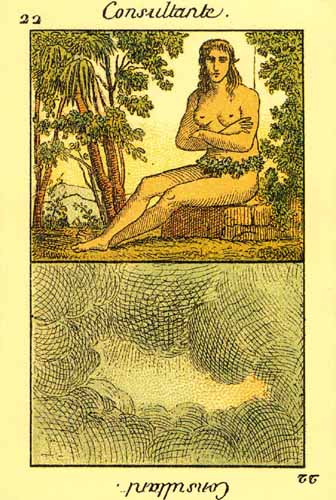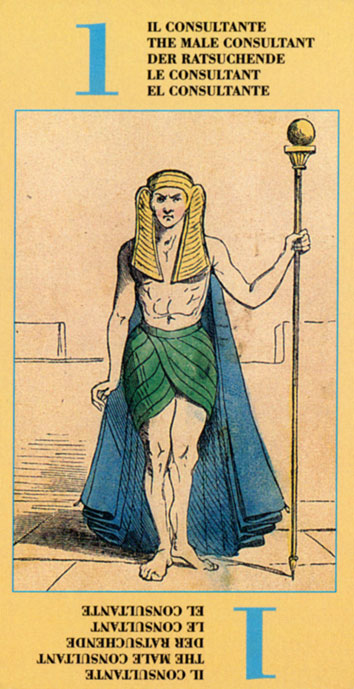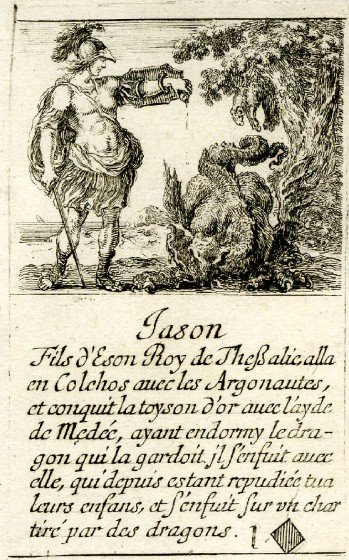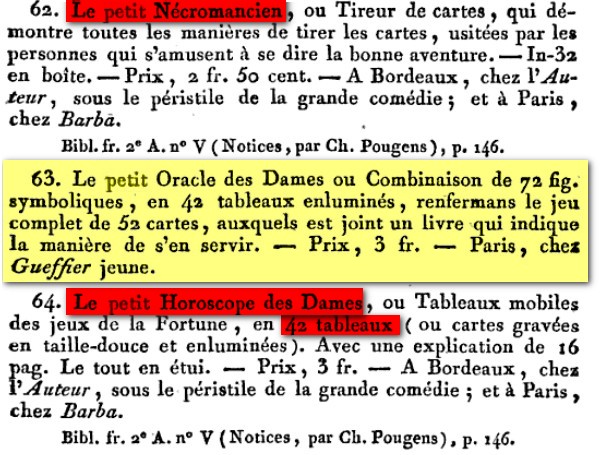You are right - I can't seem to think today.
Ah, no ...

... you seemed to think, I referred to you ... no, I meant the situation, that there are two decks (Madame Finet deck and 66 cards fortune telling deck in 1790), which seem to play a role in the genesis of the Petit oracle, and which are not reachable. This is boring ... how can we beat the drum, that we get them?
*********
Well, I see the following line of development ...
Stefano della Bella deck Mythology 1644 (52 cards)
Marolles' Ovid translation (with Chaos at begin) ... with 58 pictures
Poilly deck I (41 trumps + 56), likely c. 1660
Poilly deck II (42 cards + 56, ? also around 1660 or 1730) ... (with Chaos as first card; with 58 pictures without number cards)
Poilly deck III (22 cards + 56) ????
Etteilla deck 1788 (with Chaos as first card)
Fortune telling deck c. 1790 (66 cards) ... unknown
Madame Finet deck (1800-1805-1810 ? 36 cards, 4 from Etteilla) ... unknown
Petit Oracle (42 cards with 72/74 pictures) 1807 ... (with Chaos as card 22, the last of the Tarot cards)
... and, if we like, we can go a further deep step back, we can go to the Michelino deck (before 1425), which is in a specific manner the "first known Trionfi deck", but also the first known Mythology deck.
**********
If anybody has problems, what I want to say with the Poilly decks ...
http://tarotforum.net/showthread.php?t=170889
Also I already noted in post #173 in this thread ...
http://tarotforum.net/showthread.php?p=3020298&highlight=poilly#post3020298
Perhaps one should pay attention in the Etteilla questions to an earlier unusual Minchiate deck called "Minchiate Francesi", which was made c. 1730 (if I remember correctly). Material to it is hard to find.
But the first card is "Chaos", as in the Etteilla Tarot ...
************
Here's the Petit Oracle Chaos ...
(the lower part)
and here in an early Etteilla edition
... we have it later (Etteilla III) Grand Etteilla edition 1910
... modified to a Nr. 6 in an Lo Scarabeo deck based on an edition of 1870 (basic design according DDD from 1843, Jeu de la
Princesse) ...
... with the Magician taking the role of the Consultant
And we have an earlier Etteilla III ...
...
and in the Poilly development we had Chaos in the Marolles edition 1655 ...
..., likely made under participation of Poilly and Poilly himself had a Chaos card in Poilly version 2 ...
... and it is clear from this picture about Iason the Argonaut ...
... that Poilly knew Sefano del Bella's Mythology deck (1644):
So it's clear, that there is a complex development with "moving-the-trumps"-elements and with Chaos (all by Poilly or at least by his family), long before Etteilla started his "moving-the-trumps"-experiments and his "Chaos", which finally became the "Consultant" for some time.
Now, interestingly, the Petit Oracle of the Dames 1807 increases this world of change with playing cards, again a new Chaos, and she returns "back to 42" and with that somehow to Poilly with his 42 model. As it seems, the model depends partly at the both unknown decks, which everybody seems to have considered so uninteresting, that they nowhere appear. What can we do, that we get them?














